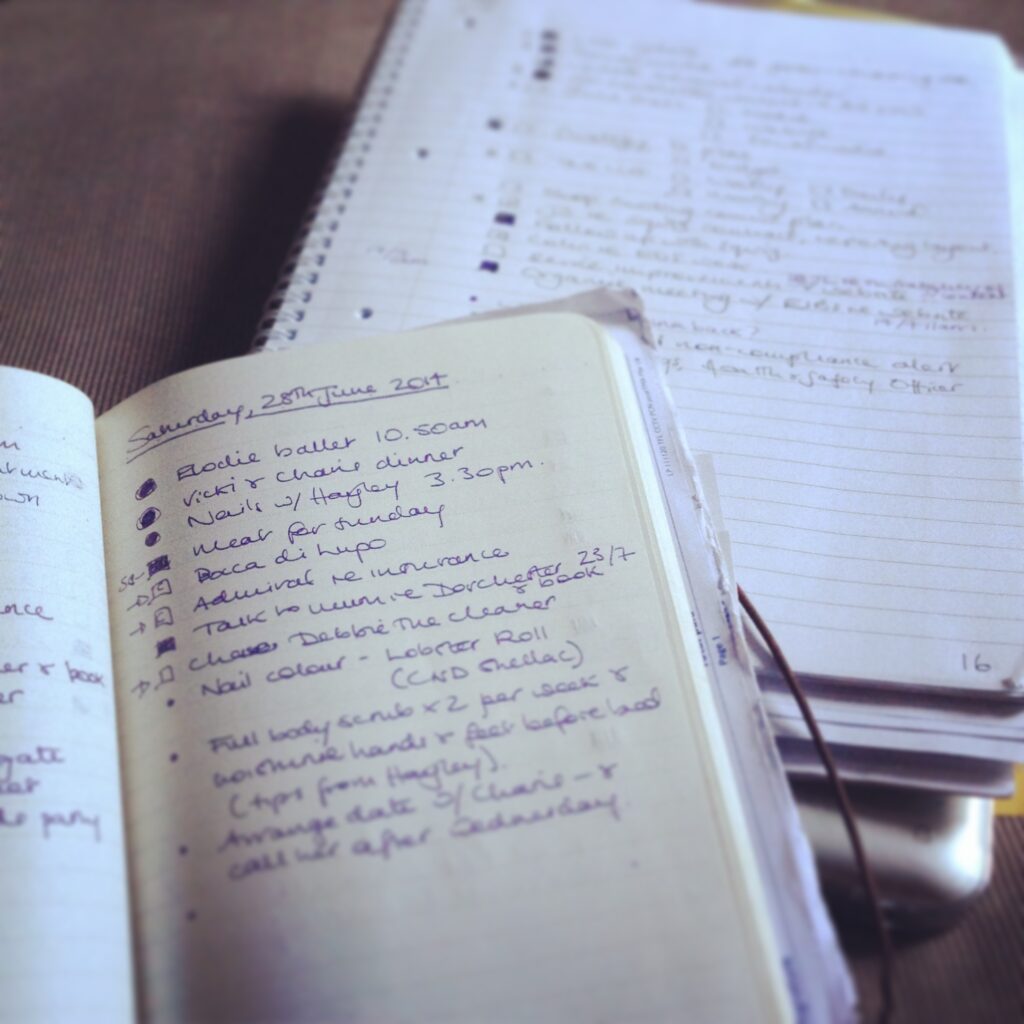Bullet journal basics: how to organise your life and stay on top of tasks

Have you discovered bullet journaling yet? If you’re constantly juggling numerous lists, tasks and competing priorities – home, work, children, projects – and never feel like you’re on top of it all then you could benefit from giving the bullet journal system a whirl. I’ve been on a mission to gain control of the numerous scattered lists I always have on the go, and to get more organised about all aspects of my life over the last few months, and key to that has been my bullet journal – or ‘mission control’ as I like to call it. Today I’m going to tell you about the basics of bullet journaling. Next week I’ll delve into some of the personalised enhancements I’ve made to make it work for me.
I’m a list writer – always have been, always will be – so if you’re not a fan of lists then you might think this system isn’t for you. Maybe it isn’t, but bear with me, it’s quick, it’s simple and I’m sure it’s helped me be more productive and focussed.
In a sentence bullet journaling is a paper-based, quick and simple notation system for keeping track of your tasks, taking notes and keeping on top of all your life. Yes you read that right, it’s PAPER-BASED, so wave goodbye to your iPhone notes and reminders and say hello to your old favourite, trusty notebook. There’s something really satisfying about a well-leafed, well-used notebook.
So far I’ve used whatever A5 notebook I’ve had to hand (I’m a stationery addict so I tend to stash pretty yet practical notebooks!) but I’ve now got a Moleskine notebook waiting in the wings to use next. I’ve used them in the past for standard journaling and I’m already using the larger version for my work bullet journal. I like the paper, I like the pocket at the back and I like that it stays open on the page you’re using without having to weigh it down with heavy objects – unlike my current pretty, but slightly annoying notebook which if you’re interested is by Go Stationery.
Bullet journaling was designed by New York art director Ryder Carroll, and to get the basic principles it’s best to visit the impressive www.bulletjournal.com to see how it works from the horse’s mouth. At the heart of Ryder Carroll’s system is the different ‘bullet’ style notations to indicate different types of entries. Here’s my key which is slightly different to Ryder’s:  Now here’s a guide to the different pages I use that keep me on track each month, week and day:
Now here’s a guide to the different pages I use that keep me on track each month, week and day:
A monthly task list. At the start of each month I write down everything I would like to get done that month. These tend to be bigger tasks, sometimes aspirational (these seem to carried over month to month! I think ‘Open bank account for E’ has been on my list since I started journaling in June last year!), sometimes very practical.  The daily page. These pages make up the bulk of the journal. Every night before I turn out the light I write my list for the next day. I go through the day just gone marking done what I’ve done or started doing, and adding anything I haven’t completed to the next day’s list, or reassigning it to another day. On any given day I carry my journal with me so I can enter anything of note such as order reference numbers, ideas and things to remember.
The daily page. These pages make up the bulk of the journal. Every night before I turn out the light I write my list for the next day. I go through the day just gone marking done what I’ve done or started doing, and adding anything I haven’t completed to the next day’s list, or reassigning it to another day. On any given day I carry my journal with me so I can enter anything of note such as order reference numbers, ideas and things to remember.
Writing a list every day may seem repetitive, but I firmly believe that writing things down repeatedly entrenches your tasks in your mind and acts as gentle persuasion to get them done so you can quit writing them down again and again. Plus it’s really satisfying to see a day full of filled in task check-boxes.  Adhoc topic pages. As referred to above I have pages dedicated to one topic such as Xmas shopping, Change of address etc etc because sometimes you need a whole page for a set of tasks that relate to each other. I note each of these in the index so they are easy to find. One topic might have several pages throughout the journal eg. notes about my blog, list related to my house purchase.
Adhoc topic pages. As referred to above I have pages dedicated to one topic such as Xmas shopping, Change of address etc etc because sometimes you need a whole page for a set of tasks that relate to each other. I note each of these in the index so they are easy to find. One topic might have several pages throughout the journal eg. notes about my blog, list related to my house purchase.
The index page. Each page in a bullet journal is numbered (I just number the pages as I go) so at the front of each notebook keep a blank page for an an index. In the index I note the page number that starts each month and the page number of any separate topic pages eg. Blog ideas, Xmas list, Schools, Change of address (I recently moved house). For the list lover this system is heaven and it works for me! I was a prolific diary writer throughout my teens and into early adulthood and there always been something about the physical act of writing things down that I find therapeutic. It solidifies things in my mind. I write it, therefore it is, or will be. I do find myself more focussed and productive as a result.
For the list lover this system is heaven and it works for me! I was a prolific diary writer throughout my teens and into early adulthood and there always been something about the physical act of writing things down that I find therapeutic. It solidifies things in my mind. I write it, therefore it is, or will be. I do find myself more focussed and productive as a result.
I use it at work as well in a less structured way (I don’t do the weekly plan as I use the calendar on my computer in a similar way) and I feel far more confident that I’m not dropping the ball, and find it far easier to keep track of all the tasks that are thrown my way.
Over the last nearly eight months I have adapted and enhanced the bullet journal system to suit me. To find out more about my personalisations read my Bullet Journal Personalisation: make the system work for you post.
Have you tried bullet journaling? Do you want to try it and want some advice about how to start? Comment below and I’ll do my best to help and don’t’ forget to follow my bullet journal board on Pinterest.


Great idea! I’m gonna give the ‘key’ concept a try. Thanks
Thanks for dropping by Tori. Good luck with it – it’s revolutionised my life!
That’s a fascinating idea. Thanks for sharing in such detail. I’m always writing lists but never thought to ‘code’ in this kind of way.
Thanks Elizabeth – give it a try. I’m addicted now!